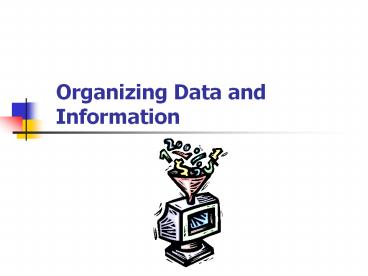Organizing Data and Information - PowerPoint PPT Presentation
Title:
Organizing Data and Information
Description:
Organizing Data and Information – PowerPoint PPT presentation
Number of Views:162
Avg rating:3.0/5.0
Title: Organizing Data and Information
1
Organizing Data and Information
2
What is Data??
- Numbers, characters, images, or other method of
recording,in a form which can be assessed by a
human or (especially)input into a computer,
stored and processed there, ortransmitted on
some digital channel. - Data on its own has no meaning, only when
interpreted by somekind of data processing
system does it take on meaning andbecome
information. - People or computers can find patterns in data to
perceiveinformation, and information can be used
to enhanceknowledge. Since knowledge is
prerequisite to wisdom, wealways want more data
and information.
3
What is Data??
4
Database Concepts
- Data
- is a valuable resource
- collection of facts/figures/observations
- storing, organizing, retrieving, sorting,
maintaining data are important activities. - to organize data you must understand
5
Some Key Terminology
- FIELDS
- A field is a single attribute of an entity
- Entity can be person, place, object, event, idea
- Field Names Each field is given a name
- Examples Name, Age, Salary
- Field Value
- Specific value/content of a field name
- Ex. Joe Blow, 30, 23000
6
Some Key Terminology
- RECORDS
- Group of related field values belonging to a
given entity under consideration - FILE
- Group of related records
- DATABASE
- Group of related files
7
Section 035
Fields Field Names Field Value
Records
8
Data Hierarchy
9
Data Hierarchy
10
Data Management
- Concerned with
- Data accuracy
- reliable source of data
- reliable data entry
- timeliness.
- Security
- protecting data to keep it from being misused or
lost (authorized access, backup) - Data maintenance
- procedures used to keep data current (adding,
changing, deleting)
11
The Traditional Approach To Data Management
12
Limitations of Files
- Data Redundancy duplicate fields in multiple
files - Data Inconsistency identical fields have
different data - Data Isolation inaccessibility of data from
other applications - Security nonexistent
- Data Integrity accuracy of data in records
13
Database
- A Database - an organized collection of related
data that can service many applications at the
same time. - A collection of data is not per se a database.
- Organized means that you can easily find what you
want. - Related means that the data have significance
when viewed together.
14
Data Entities and Attributes
- Entity
- Generalized class of people, places, or things
for which data is collected, stored, and
maintained - Examples of entities include employees,
customers, and inventory - Attributes
- A characteristic of an entity
- For example, employee number, last name, first
name, hire date, and department number are
attributes for an employee
15
Keys
- Key
- A field or set of fields in a record that is used
to identify the record - Primary Key
- A field or set of fields that uniquely identifies
the record
16
Keys and Attributes
17
The Database Approach to Data Management
18
Advantages of Database Approach
- Improved strategic use of corporate data
- Reduced data redundancy
- Improved data integrity
- Easier modification and updating
- Data and program independence
- Better access to data and information
- Standardization of data access
- Framework for program development
- Better overall protection of the data
- Shared data and information resources
19
Disadvantages of Database Approach
- Relatively high cost of purchasing and operating
a DBMS in a mainframe operating environment - Increased cost of specialized staff
- Increased vulnerability
20
Database Models
- Hierarchical (tree)
- Network
- Relational
21
Hierarchical Database Model
22
Network Database Model
23
Relational Database Model
24
A Relational Database Model
Link via a common field between tables
25
Relational database and keys
- A relational database is a collection of tables
that are related to one another based on a common
field. - A field, or a collection of fields, is designated
as the primary key. - The primary key uniquely identifies a record in
the table. - When the primary key of one table is represented
in a second table to form a relationship, it is
called a foreign key.
26
Relating tables using a common field
27
Linking Database Tables to Answer an Inquiry































